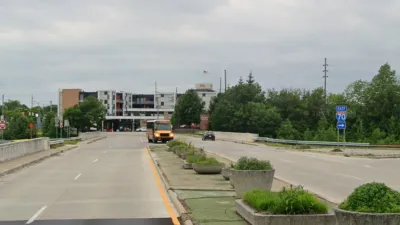An explainer from Momentum highlights the advantages of reducing vehicle lanes in favor of more bike, transit, and pedestrian infrastructure.

An explainer from Momentum Magazine outlines the benefits of road diets, a popular but controversial traffic calming strategy that focuses on reducing the number of vehicle lanes and adding sidewalks and other bike and pedestrian infrastructure to streets.
According to author Ron Johnson, “ The first road diet in the United States was implemented in 1979 in Billings, Montana. Since then, cities like Charlotte, Chicago, San Francisco, and New York have all embraced the model. But it’s not just a design trend—road diets are backed by powerful data and safety results.”
Reducing the number of lanes and average speeds can cut crashes by as much as 52 percent, and slower speeds also mean crashes can be less serious when they do occur.
Although road diet opponents worry about traffic, “Removing travel lanes can actually lead to a reduction in overall vehicle trips—a phenomenon known as traffic evaporation. Some drivers shift to alternative routes or, increasingly, to alternative modes of transport.” Better bike and pedestrian infrastructure incentivizes more people to use those modes, and bus lanes make transit a more reliable option. Road diets thus also lead to reduced carbon emissions and cleaner air.
“As our cities continue to evolve, road diets offer a cost-effective, data-backed, and scalable way to make them safer, cleaner, and more livable,” Johnson concludes.
FULL STORY: Explainer: What Is a Road Diet—And Why Should Cities Embrace It?

Maui's Vacation Rental Debate Turns Ugly
Verbal attacks, misinformation campaigns and fistfights plague a high-stakes debate to convert thousands of vacation rentals into long-term housing.

Planetizen Federal Action Tracker
A weekly monitor of how Trump’s orders and actions are impacting planners and planning in America.

Chicago’s Ghost Rails
Just beneath the surface of the modern city lie the remnants of its expansive early 20th-century streetcar system.

Bend, Oregon Zoning Reforms Prioritize Small-Scale Housing
The city altered its zoning code to allow multi-family housing and eliminated parking mandates citywide.

Amtrak Cutting Jobs, Funding to High-Speed Rail
The agency plans to cut 10 percent of its workforce and has confirmed it will not fund new high-speed rail projects.

LA Denies Basic Services to Unhoused Residents
The city has repeatedly failed to respond to requests for trash pickup at encampment sites, and eliminated a program that provided mobile showers and toilets.
Urban Design for Planners 1: Software Tools
This six-course series explores essential urban design concepts using open source software and equips planners with the tools they need to participate fully in the urban design process.
Planning for Universal Design
Learn the tools for implementing Universal Design in planning regulations.
planning NEXT
Appalachian Highlands Housing Partners
Mpact (founded as Rail~Volution)
City of Camden Redevelopment Agency
City of Astoria
City of Portland
City of Laramie





























